When I got my first bunny, Commander Bun-Bun, she was a shy, timid little Bunny that would run and hide whenever anyone walked by her cage. That changed fairly quickly. Now, at almost six years old, she loves to be brushed and she loves spending time on my couch with me. It took time and patience, but the effort was worth it. If you’re a new Bunny owner or you’re considering becoming one, this guide will walk you through the basics of caring for your new furry friend with all the information presented in a helpful question/answer format.

Is a Bunny Right For Your Family?
Q: Is a bunny a good pet for kids?
A: Supervised, a bunny makes a great pet for kids but you need to help them care for it. With younger children, constant supervision during play time is vital. It isn’t hard for a child to accidentally hurt a small animal during what they feel is harmless play. Not only could they hurt Bunny, but if Bunny isn’t happy, it may also hurt your child. To avoid Bunny nips, make sure you take the time to socialize Bunny before allowing your kids to try to hold.

Q: Do bunnies and dogs get along?
A: Whether or not your new Bunny will be able to live in harmony with your dog will depend on three factors – you, your Bunny and your dog. If your dog is hyper and not very obedient, it is not safe to have your rabbit out of its cage when the dog is in the house. A rabbit and an obedient dog, on the other hand, will get along just fine. Let’s use my dog, Deniro, and Commander Bun-Bun as an example.
Deniro is a big, clumsy meathead. She’s also a very smart girl who listens very well. We began introducing Deniro and Bun-Bun when we first brought Bun-Bun home bit it took a lot of patience. Deniro is a big girl (a cross between a Doberman and a German Shepherd) that gets wound up like a tiny lap dog. She was excited to have a new friend in the house (at this time, Deniro was an only pet) and wanted to play! Play! Play! This did not sit will with the skittish Bun-Bun. They eventually learned to get along even though Bun has to occasionally put up with sloppy dog kisses.
You need to know your dog before you allow Bunny to roam while the dog is in the house. If your dog does not listen to you when you say ‘no’, your bunny is not safe with your dog. Let Bunny out while your dog is outside. Your dog will be happy with the fresh air and exercise and your Bunny will get the exercise it needs.
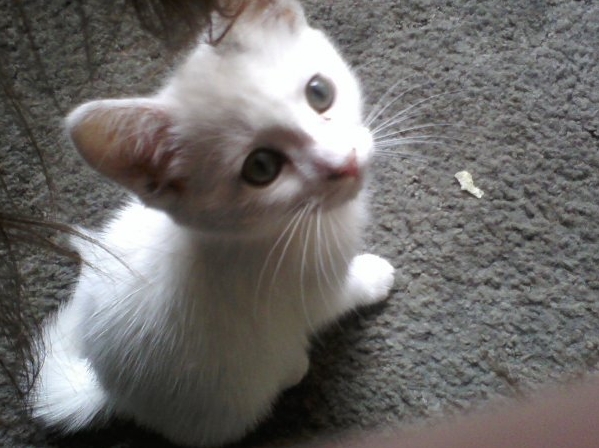
Q: Do bunnies and cats get along?
A: This probably goes without saying, but here it is anyway – dogs and cats are two completely different beasts. Cats are predatory animals. Their natural instinct is to hunt. This can definitely make trouble for Bunny. Whether or not they are able to get along will depend on not just whether you can teach your cat that Bunny is not prey but will also depend on how big your cat is and how big your rabbit is. My cat, Speeze, is small for a full grown cat. Bun is big for a full grown dwarf rabbit, but they get along just fine. It just took a little time and a lot of patience.
Bunnies are social creatures. They are happiest when they have another furry companion. Cats, on the other hand, are solitary creatures and prefer a life on their own. This causes a unique kind of power struggle between cat and rabbit. If your cat is smaller than your rabbit, the rabbit will become the aggressor and chase the cat. This is the rabbit’s way of trying to assume the alpha role. This isn’t something you want to encourage. Because it is a cat’s instinct to flee and not fight (except with other cats, of course) the cat will run, but will defend itself if cornered. Since you don’t want either animal to be injured, you need to try to avoid allowing the chase to happen.
If your cat is larger than your rabbit (as is most often the case), the opposite of the above will be true. The cat will see the rabbit as prey and will try to hunt it. This is where the age of your cat will come into play. An adolescent cat will not yet know how to control those stalking/hunting instincts and your rabbit will be in trouble. This doesn’t mean they can’t learn to get along. It just takes a little effort.
Feeding Your Bunny
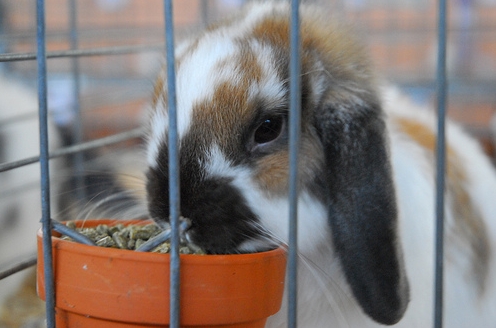
Q: What should I feed my bunny?
A: Pellets will be a staple of your bunny’s diet, but choosing the right kind of pellet is important. Look for a high fiber pellet that is also low in protein and calcium – somewhere in the area of 20-25% fiber, 14-15% protein and less than 1% calcium is best. Avoid the ‘gourmet’ bunny food that contains nuts or seeds. In my experience, bunnies prefer the regular pellets anyway.
Hay is an important part of any bunny’s diet and should be kept readily available to your rabbit at all times. Hay is high in fiber and helps promote a healthy digestive system for your rabbit. It also helps ware down your rabbit’s teeth which is incredibly important. Alfalfa is a great option for younger rabbits, but should be avoided for older rabbits as it is high in sugar and protein. Older rabbits will benefit the most from timothy hay or oat hay. Fresh grass is also great for older bunnies. You can buy hay at most pet stores, but it’s often a lot less expensive to buy in bulk at a farmer’s market. Just make sure you choose hay that looks and smells fresh. Avoid buying anything that is moldy.
Vegetables are also an important part of Bunny’s daily diet. There are some vegetables your rabbit will like and other vegetables they won’t – just like people. Give new vegetables to Bunny in small quantities so you can get a feel for how Bunny responds to them. Some great veggies to try include:
- Basil
- Broccoli (leaves only – never stems and or tops)
- Carrot tops (in small quantities)
- Celery
- Cilantro
- Clover (in very small quantities)
- Collard greens
- Dandelion leaves
- Dill
- Mint
- Parsley
- Romaine or dark leaf lettuce (not iceberg lettuce)
- Watercress
*Always make sure you wash any store bought vegetables well before you feet them to Bunny the same as you would if you were feeding them to your family. Pesticides are dangerous for rabbits.
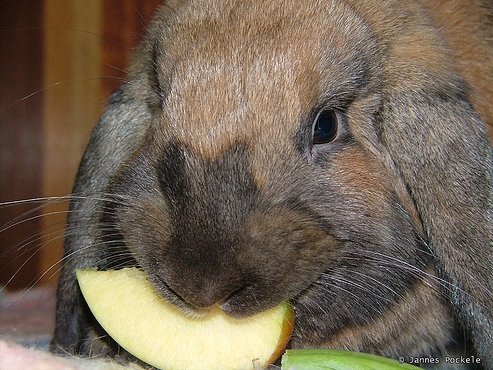
Q: What are good bunny treats?
A: Wanting to give your bunny a treat is great and will definitely help with training and socializing, but you need to be sure you’re giving your bunny the right kind of treat. Avoid anything high in carbohydrates like breads, cereals, chips, cookies, pasta and pretzels. Most commercial bunny treats (like yogurt treats) should also be avoided.
Fresh fruit makes for a great bunny treat. Remember though – fruit is meant to be a treat. Most fruits are very high in sugar which isn’t a good thing for Bunny. Give fruit to your bunny in small quantities and only occasionally. As with vegetables, make sure any fruit you give Bunny has been washed well. Some great bunny treats include:
- Apples (without the seeds)
- Bananas
- Pineapples
- Raspberry
- Strawberries

Q: What foods are forbidden for bunnies?
A: Although Bugs Bunny eats carrots, carrots are not healthy for your bunny. Carrot tops are fine in small quantities, but be sure you’re careful not to give them too much of the root part of the carrot. There are foods that are absolutely forbidden. This is important. If you feed your bunny foods from the following list it could get sick or possibly even die. The following foods are off limits for Bunny:
- Broccoli stems and tops
- Cabbage
- Carrots
- Chocolate
- Iceberg lettuce
- Parsnips
- Potato tops
- Tomato leaves
- Swedes
It’s also important to be careful where you let your bunny roam in the house or outside. These common plants and flowers could seriously harm Bunny so avoid letting your bunny roam in areas that contain:
- Anemonies
- Arum lilies
- Bluebells
- Buttercups
- Clover (in large amounts – small amounts are okay)
- Daffodils (and other bulbs)
- Dahlia
- Deadly nightshade
- Delphiniums
- Fairy Primrose
- Foxglove
- Hemlock
- Honeysuckle
- Iris
- Ivy
- Jasmines
- Larkspur
- Poppies
- Primulas
- Snowdrops
- Tulips
Keeping Bunny Happy: Entertainment for Bunny
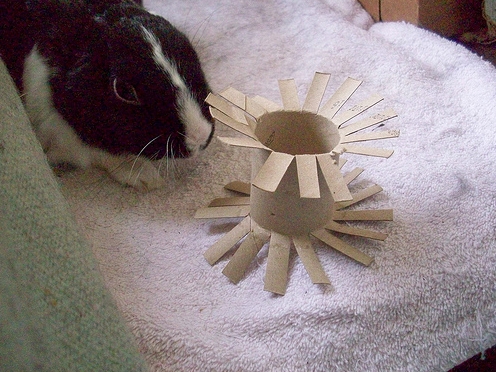
Q: What are good toys for bunnies?
A: Toys are important in keeping bunnies happy, but you don’t have to buy toys at a pet store to keep your bunny entertained. Some great bunny toys include:
- Bird toys (especially toys with mirrors)
- Cardboard boxes
- Cardboard tubes (such as toilet paper or paper towel rolls)
- Digging boxes (a box filled with sand or unscented cat litter)
- Dried branches
- Dried pinecones
- Paper
- Phone books (one of the best chew toys out there)
- Rattles
- Rubber balls (the large rubber balls you can buy for kids at toy stores or discount stores)
- Slinkies
- Teething rings
- Towels (great for tug-o-war matches with your bunny and also great bedding)
- Untreated wood
There are some great toys you can buy at pet stores, but Bun-Bun likes her cardboard tubes far more than any toy I’ve ever bought her. Her all time favorite toy, though, is an old phone book I gave her. Be creative but be careful. You don’t want to give Bunny anything that she could hurt herself with.
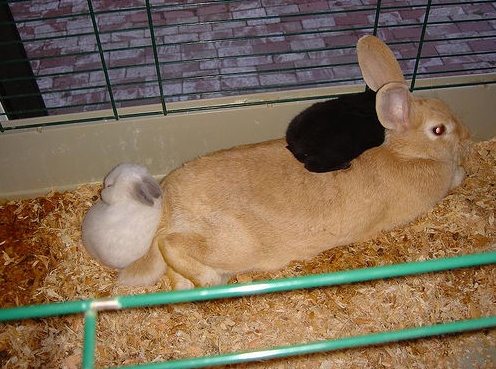
Q: Will my bunny be happy in its cage?
A: Your bunny will not be happy spending all of its time in a cage. Your bunny needs exercise and it will want to explore the house. I would recommend having one area of the house designated for bunny to roam around in until it is more accustomed to its surroundings.
It is often said that bunnies need at least one hour of time outside of the cage every day. Bun-Bun gets out of her cage a bit more often than that. I’ve taken precautions to make my home ‘bunny-proof’ so I feel safe leaving her more or less unsupervised for short periods of time. She also gets along well with my other pet.
Bunnies like time outdoors as well. I have a bunny run outside where Bun can run around, munch on grass but where she is also protected from predators and has a safe place to hide when she’s scared. In my next bunny article, I’ll walk you through building an outdoor bunny run that your new pet will love.

Summary
There you have the basics of getting started with your new bunny. Choosing the right food and keeping them entertained are two of the most important parts of caring for your rabbit. In upcoming articles, I’ll walk you through socializing your bunny, introducing your bunny to other pets in the household, litter training your bunny, training your bunny, building an outdoor bunny run and common health problems bunnies face and how you can help avoid them. Make sure you check back for these helpful guides.
Is there something you want to know that wasn’t covered in this article? Is there something you’d like to see in upcoming articles? Let me know in the comments section below and I’ll do my best to help. Thanks for reading!











